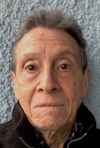 [Jerry N. Uelsmann (June 11, 1934-April 4th, 2022) died on April 4 in Gainesville, Florida. He was 87. The cause was complications of a stroke. For his New York Times obituary by Richard Sandomir, click here.
[Jerry N. Uelsmann (June 11, 1934-April 4th, 2022) died on April 4 in Gainesville, Florida. He was 87. The cause was complications of a stroke. For his New York Times obituary by Richard Sandomir, click here.
Uelsmann’s early works numbered among those that drew me into writing about photography; I saw his 1967 show at the Museum of Modern Art, curated by Peter Bunnell, and subsequently read with great interest the lengthy 1971 essay on his work by William Parker, published in an aperture monograph, that approached his imagery from a Jungian perspective.
Indeed, one of my first Village Voice columns, published in September 1968, addressed Uelsmann’s work at some length. In return, I received a note from him — handwritten on the back of a work print, as was his habit — thanking me and encouraging me to continue my work. (During those first months after hanging out my shingle as a photo critic I also got a supportive note from John Szarkowski of MoMA’s Department of Photographs. I framed both and hung them on my office wall.)
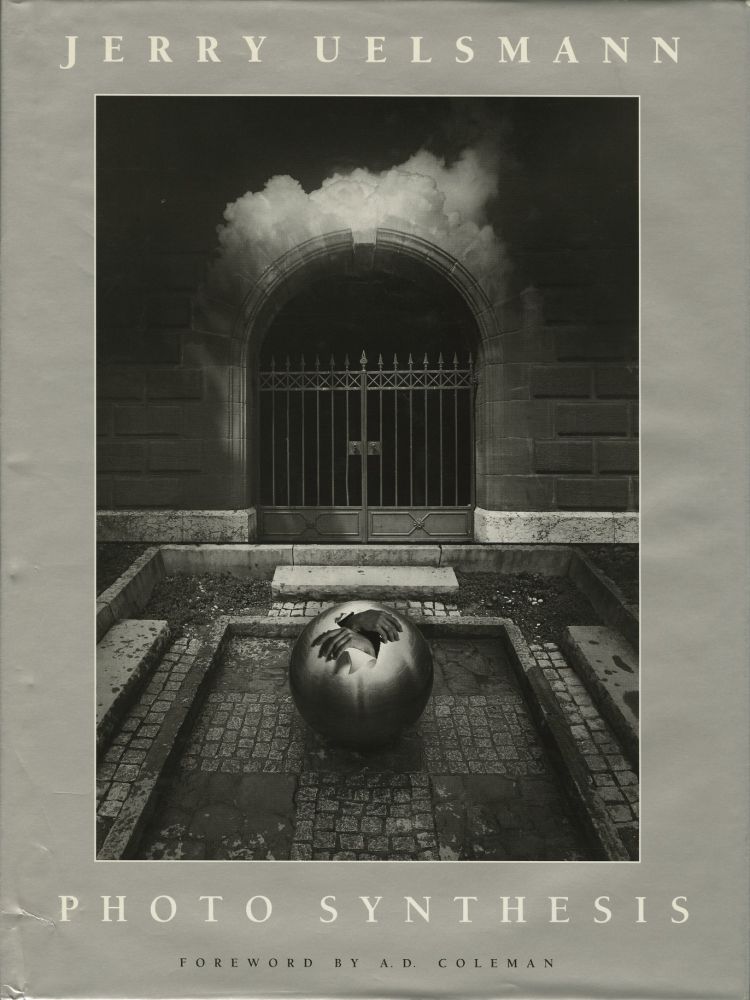
Jerry Uelsmann, Photo Synthesis (1992), cover
Sometime not long thereafter I met Jerry — I’ve forgotten exactly where, so I’ll guess either at a Society for Photographic Education conference or else at a gallery opening in New York. I included a portfolio of his work in my 1977 critical survey, The Grotesque in Photography; reviewed exhibitions and publications of his at intervals; and used his work as a reference point and gauge for contemporary photomontage.
In 1992 Uelsmann invited me to contribute the introduction to his monograph Jerry Uelsmann: Photo Synthesis, published by the University of Florida Press. Both before and after that Jerry and I ran into each other periodically — at SPE gatherings, at openings of his shows, and at other photo events. As I recall, our paths last crossed in 2016, at AIPAD’s “Photography Show,” where he was happily signing books and greeting colleagues and admirers.
In fall 2008 I curated a two-person exhibition of work by Jerry and his then-wife Maggie Taylor, “Prima Facie/Circumstantial Evidence,” for See+ Artspace/Gallery, located in the famous 798 Art District of Beijing. The show came accompanied by small, separate, handsome monographs by Uelsmann and Taylor. My curatorial essays for the exhibition served double duty as both wall texts for the show and introductions to the books. Below you’ll find what I wrote then about Uelsmann’s work, my most recent discussion thereof. (For a PDF download of the text, click here.) — A.D.C.]
•
Jerry Uelsmann: Prima Facie
adverb:
At first sight; before closer inspection.
adjective:
1. True, authentic, or adequate at first sight; ostensible.
2. Evident without proof or reasoning; obvious.
The photomontages of Jerry N. Uelsmann are as instantly recognizable as any photographic images made in the second half of the 20th century. Today they stand as germinal, the progenitors of an approach to photographic image-making so well-established and widespread that it’s strange to recall (and, for a younger audience, no doubt difficult to imagine) the storm of controversy that raged around them as they first began appearing in the early 1960s.
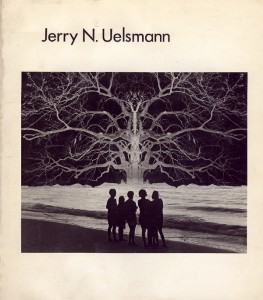
Jerry N. Uelsmann (1971), with introduction by William Parker
When Uelsmann began working in this form of photography almost five decades ago, the context in which he labored was diametrically opposite to that in which he functions today. Partly due to his consistent and determined efforts — as practitioner, as theorist, as teacher, as public lecturer, and generally as exemplar — the working definition of what constitutes the full field of ideas and strategies in contemporary photography is a far more expansive one than that which was operative when he set out on his path.
Unlike photocollage, with which it’s sometimes confused, photomontage is generated on photographic paper or film and often looks — at least at first glance — like unmanipulated imagery. As Uelsmann’s oeuvre demonstrates, even when the combinatorial nature of the finished work is recognized it may offer little or no indication of where one component ends and another begins. Those who employ it deliberately propose a radical alternative to the naturalism that has been the stock-in-trade of photography since its inception. Photomontage provides unsettling evidence that, paradoxically, although the camera must always address something in front of the lens, some photographs portray events that never happened.
These are not documents of any single moment of external “reality.” Their purpose is not to delude the viewer into the permanent conviction that the world really looked that way. Instead, they contradict the viewer’s assumptions concerning the predictability and literalness of the photograph. This heightens awareness of the imagery’s artificiality, evoking a different set of questions in regard to its purpose.
•
Dispute has always swirled around this practice. Photomontage first attracted widespread attention in the mid-nineteenth century through the directorial, literary work of Henry Peach Robinson and O. G. Rejlander, whose techniques and results were the subject of heated and even violent debate among photographers and critics. Vernacular photography — postcard imagery and portraiture in particular — popularized it. In the 1920s it became a staple of modernist practice in Europe, even entering the photography curriculum devised for the Bauhaus by László Moholy-Nagy, who called it “simultaneous seeing by means of transparent superimposition.” But modernists in the U.S. repudiated it, and the photo-historical establishment in the States, sharing their biases, virtually banished it from the scene.
Yet even when photomontage fell into disfavor, it refused to die. Before Uelsmann and others of his generation began exploring this set of practices, such North American experimenters as Barbara Morgan, Edmund Teske, Clarence John Laughlin, and Val Telberg were pursuing them. However, in the U.S. photo scene after World War II, the “purist” approach advocated by such figures as Edward Weston, Ansel Adams, and the West Coast school was dominant. They preached what Adams called “pre-visualization” — the full realization of the image at the moment of exposure; by their lights, any subsequent tampering with the data on the negative was anathema.
•
Uelsmann — goaded into his inquiry by his mentor at Indiana University, the late photographer, educator and theorist Henry Holmes Smith — set out to demonstrate that there was another way. In the late 1950s and early 1960s (during and after his graduate studies under Smith) Uelsmann devoted a great deal of study, experiment, and energy to reviving the processes he found relevant to his vision. Compiling and using an image bank of negatives from which he could draw specific components, he evolved an idiosyncratic methodology. In this approach to praxis, the darkroom became a locus for what Uelsmann refers to as “in-process discovery.”
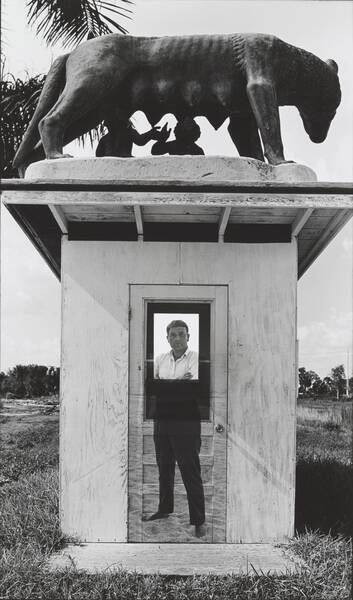
Jerry Uelsmann, Portrait of Peter Bunnell, 1968
Eventually, he developed his printmaking skills to the point where he could blend any number of those components seamlessly into one final image. (Eschewing the expedient of the copy negative, which many photomonteurs employ as a labor-saving device, he continues to make each gelatin-silver print of any given image by reassembling the component negatives and starting from the beginning.) By the middle 1960s he’d produced a body of work that in his opinion proved the viability of photomontage as a contemporary image-making strategy, along with a theory and a teaching methodology to go with it.
Then he took the step — rare in photography, though not uncommon in the other creative media — of issuing an articulate, cogent manifesto-cum-credo, explaining in broad terms what he was doing, why he was doing it, and why he continued to call himself a photographer. Publishing in 1967 a position paper that described his contrary methodology as “post-visualization,” this seemingly mild-mannered Detroit native threw down his gauntlet. In the words of curator and historian Peter Bunnell, this challenge — and the way in which Uelsmann has risen to its demands as a picture-maker over the years — can appropriately “be seen to have altered the language, the substance, and the direction of [the medium itself].”
•
Issued at that particular historical moment, “Post-Visualization” virtually guaranteed that Uelsmann would find himself in the eye of a storm for years to come; not only did it declare its author’s intent to serve as a spokesperson for the approach described therein, but it implied his willingness to have his work treated as a litmus test for the theory’s validity, an example of its application in practice. Surviving severe criticism and outright rejection of his initial efforts by his peers, Uelsmann persevered, finding an audience and forging a major body of work in this form over the next four decades. Even now there’s little to gauge it by except itself, for it’s against Uelsmann’s masterworks that the field measures itself.
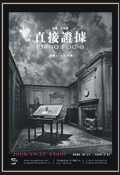
See+ Gallery, Beijing, Uelsmann poster (2008)
From the beginning, Uelsmann has elaborated a sometimes obliquely and sometimes directly autobiographical dream-world. This microcosm partakes of the surreal, in its non- or anti-literal evocation of dreams, fantasies, visions, and hallucinations, as well as in the recurrent symbol of the hand, a key element in classic surrealist photography. It also is imbued with strong elements of the grotesque, in that term’s traditional art-historical meaning. Grotesque motifs throughout his imagery include bizarre apparitions of disembodied human parts, the merging of human beings with various natural objects, and the blending and intertwining of other animal, mineral and vegetable forms.
Yet these images resist easy categorization: to label Uelsmann a surrealist, a pantheist, a mythologist, or a diarist is to disregard other, equally significant aspects of his work. What seems inarguable is that, in addition to proving the validity of his approach by producing imagery that at its best is unsettling, enchanting, magical, and oddly melancholy, Uelsmann has demonstrated a remarkable consistency of vision. Again and again in his imagery, a lonely and often shadowy male figure (a stand-in representing the photographer) searches convoluted, mysterious, multi-dimensional scapes pervasively animated by the Feminine, seeking contact with the Other. Fundamentally, he’s a wanderer through inner space, a lyric poet using a new language to recount his adventures. And part of the pleasure of engaging with Uelsmann’s photographs is that the dance of symbols therein never seems theory-driven, intellectualized, or otherwise forced, but emerges, unpremeditated, through play and experiment.
•
Due to the omnipresence of digital imaging systems today, darkroom-based photomontage as a craft can already be considered archaic. (Indeed, the Rochester Institute of Technology, where Uelsmann studied the medium as an undergraduate, will begin to teach gelatin-silver printing itself as an “alternative process” in the fall of 2008). Ironically, versions of the disputes that took place over Uelsmann’s early imagery within the microcosm of the photography community in the 1960s are now appearing in the mass media, in relation to the increasing prominence of electronically generated composite images.
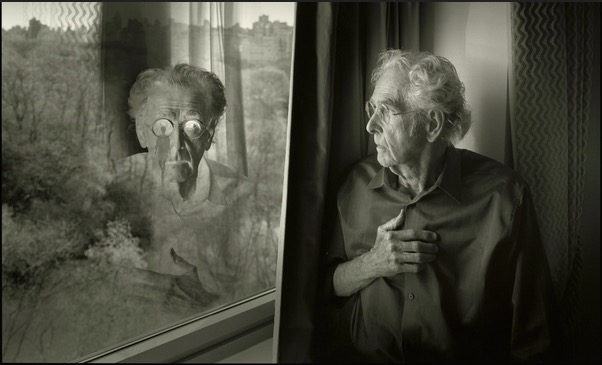
Jerry Uelsmann, Questions of Self (2015)
It seems to be Uelsmann’s fate to have established darkroom-generated photomontage as legitimate and viable within classic photographic practice by bringing it to its pinnacle of virtuosic expression, only to witness the obsolescing of that practice in its entirety by the onslaught of electronic imaging. In that sense, he constitutes a terminus. But we can also view him as a springboard: in building a wide international audience for his own imagery and encouraging his colleagues in their parallel experiments, he helped prepare that receptive soil in which computer-generated imagery has now taken root.
Yet, as long as he’s permitted to pursue his own inclinations, he doesn’t appear to regret that cultural transition. This was never a man spoiling for a fight over what was or was not permissible in creative photography, merely someone whose vision carried him into one. Still, it’s safe to say that no future study of the history of photomontage will be considered seriously unless it takes the theory, the practice, the teaching, and — most importantly of all — the imagery of Jerry Uelsmann into account.
•
This post sponsored in part by a donation from George Malave.
•
 Special offer: If you want me to either continue pursuing a particular subject or give you a break and (for one post) write on a topic — my choice — other than the current main story, make a donation of $50 via the PayPal widget below, indicating your preference in a note accompanying your donation. I’ll credit you as that new post’s sponsor, and link to a website of your choosing.
Special offer: If you want me to either continue pursuing a particular subject or give you a break and (for one post) write on a topic — my choice — other than the current main story, make a donation of $50 via the PayPal widget below, indicating your preference in a note accompanying your donation. I’ll credit you as that new post’s sponsor, and link to a website of your choosing.
And, as a bonus, I’ll send you a signed copy of my new book, poetic license / poetic justice — published under my full name, Allan Douglass Coleman, which I use for my creative writing.






A good tribute to the man and his work. AD built a good historical context for seeing his work. I had the honor of being his lab assistant as he worked at Buffalo State College. I learned a lot just watching him work and discussing his process and work. That was back in 1968.
An incredible, generous, kind, humor-full human being … as pure and full an artist as anyone in history.
A personal friend of over 70 years never to be forgotten.
Jerry was one of my early heroes and the opportunity to work with him on the 20×24 was a highlight of my career during the Polaroid years. Rightfully skeptical of this giant machine Jerry returned to his roots a bit to perform all in camera effects, double and triple exposing, changing scale and weighting exposures to create “Uelsmannesque” color 20×24 Polaroid images. We worked several times in the 1980s but would often meet up at various conferences and festivals. He was incredibly generous in trading images with me on several occasions and I will always treasure those and my time spent with him.
I met Jerry in 1964 in O’Hare airport when our plane on down to Urbana — where I attended graduate school and he was visiting the art department — was grounded. We talked in the airport and the limo hired by the airline to take us down.
He showed me his portfolio and I knew I was in the presence of genius. His photomontages…he told me the name…reached through to my soul.
We formed a ‘meet once a year’ friendship that was only left when his new wife, Maggie Taylor, told him no more female friends or no marriage. She much later gave him two weeks notice she was leaving for a younger man.
We were in touch again. He was pushing himself even harder into his work, bereft that he had lost the person he had expected to live out his old age with. He sent me several of his prints which I treasure, since he had a stroke after.
An era was over. I heard about his death from a friend who read about it in the New York Times. If only once more we could meet and dance down a busy street, like in our youth, people staring.